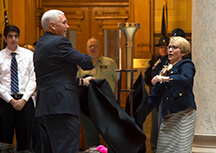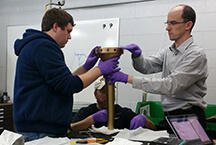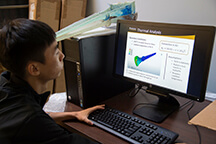State unveils Bicentennial Relay torch from Purdue Engineering
December 11, 2015
 |
|
Indiana Gov. Mike Pence and Lt. Gov. Sue Ellspermann on Friday (Dec. 11) unveil a functioning prototype of the bicentennial relay torch designed by a team of Purdue Engineering faculty and students. The unveiling was part of Statehood Day events at the Statehouse in Indianapolis. (Mark Simons) |
INDIANAPOLIS — It will pass between more than 1,800 people next year, but on Friday (Dec. 11) the Bicentennial relay torch designed by Purdue University engineering students only had to handle one hand-off.
A functional prototype of the flagship torch designed to be used in the 2016 relay to mark Indiana’s Bicentennial was given to Gov. Mike Pence as part of Statehood Day events at the Statehouse in Indianapolis.
Students from several schools in the College of Engineering, along with Timothée Pourpoint, project manager and associate professor of aeronautics and astronautics at Purdue, were on hand for the official unveiling.
“For Purdue to be involved is absolutely fitting,” Pourpoint said. “We’re a top engineering school in the country and the world. For us to design it is a great honor.”
The flagship torch - a project almost a year in the making - is one of three torches that will be used during the relay, which begins in September and will cover all 92 counties. Purdue engineering students designed two other torches – a children’s torch for the younger torch-bearers and one that will carry a flame at high rates of speed.
 |
|
Engineering student Matt Elliott, left, works with Professor Timothée Pourpoint, right, and Robert McGuire, technical services supervisor for Zucrow Labs, to place the burning unit on the Bicentennial torch prototype. (Purdue University photo/Brian Huchel) |
The final version of the flagship torch weighs nearly 5 pounds and stands around 2 feet tall. Once completed, it will be made entirely of an aluminum lithium alloy from Alcoa Inc.’s Lafayette plant. The prototype torch delivered to Pence is made completely of aluminum, making it slightly heavier than the final manufactured version.
In staying with state roots, the torch’s burner flame is fueled with E85, a blended ethanol-based fuel made partly with corn.
Students have been designing the torch since the spring semester. Purdue’s School of Materials Engineering manufactured the shell of the torch during mid-November with final testing of the entire system happening this week.
The project was a group affair, with about 50 students, faculty and staff involved since the beginning of the calendar year. The effort going into the project was split among the Purdue’s schools in the College of Engineering.
Students in the School of Aeronautics and Astronautics designed the body of the torch and used their knowledge of combustion systems to design the burner. The Department of Agricultural and Biological Engineering was tasked with handling and testing the E85 torch fuel, and the School of Materials Engineering worked on the manufacturing and anodizing of the torch’s body. The electronics and software angles – including never-before-used GPS and camera functions with WiFi and cellular connectivity – were handled by two student teams working in the School of Electrical and Computer Engineering.
 |
|
Engineering student Tainyu Xu looks over an analysis of the heat expected to be emanating from the Bicentennial torch prototype. (Purdue University photo/Mark Simons) |
For the children’s torch, a team from the Engineering Projects in Community Service program tackled the design and creation, as well as an accompanying education effort for middle school students. The Environmental and Ecological Engineering division also worked on the education side with an overall eco-initiative including environmental profiles of each county along the 2,300-mile relay route.
The two ECE teams informally competed on the project, submitting differing packages for the torch’s electronics aspect. Mark Johnson, director of the Instructional Laboratories, who oversees one of the teams, said students had to “sacrifice their time and some of their sleep to be able to pitch in on this.”
“What happened is even though we decided to not push the competition aspect, the students on their own have picked up the competitive spirit of it. Both teams wanted to see their product on the torch.”
Pourpoint detailed how the number of interested engineering students grew with each semester.
“It’s not just designing a little gadget that will stay at the back corner of a lab for the next group of students,” Pourpoint said. “It’s something that will be very public. That robustness of design and importance of having an aesthetically beautiful torch is something that we took pride in.”
Next year’s relay route begins on Sept. 9, 2016, in Corydon, the state’s first capital, at the southern tip of Indiana. The relay, an initiative of the Indiana Office of Tourism Development, culminates Oct. 15, 2016, in Indianapolis on the Statehouse grounds.
“Indiana has the great fortune of being home to Purdue University, the world’s preeminent engineering school,” said Mark Newman, executive director of IOTD. “This terrific team of Purdue faculty and students have created a lasting symbol for our bicentennial, one that will endure long after the relay concludes.”
Writer: Brian L. Huchel, 765-494-2084, bhuchel@purdue.edu
Sources: Timothée Pourpoint, 765-494-9423, timothee@purdue.edu
Mark Johnson, 765-494-0636, mcjohnso@purdue.edu
Related release
Purdue team creates high-tech torches for Indiana bicentennial
Note to Journalists: A directory with video B-roll and soundbites is available at https://drive.google.com/folderview?id=0BxdPFMVWz-l2VzJPTXg4dWhrTEE&usp=sharing

